AMD Announces Ryzen 4000 Renoir APUs: Up to Eight Cores For Pre-Built OEM Systems Only
OEMs get all the love

In a move to expand its penetration into the massive pre-built system market, AMD announced that its opening salvo of the hotly-anticipated Ryzen 4000 'Renoir' desktop APUs are aimed directly at OEM builders. That means these Zen 2 chips won't be found in the retail market and won't contend for our list of Best CPUs. Instead, they'll be available only for pre-built systems from OEMs. AMD says it will deliver unspecified next-gen APUs for the DIY market (400- and 500-series motherboards) at an undetermined time. AMD also announced the Athlon 3000 G-Series chips and the Ryzen Pro 4000 G-series of processors for the professional market.
| CPU | Cores/Threads | Frequency (Up to) Boost / Base | Graphics Cores | Graphics Frequency | TDP | Cache |
| Ryzen 7 4700G | 8 / 16 | 3.6 / 4.4 | RX Vega 8 | 2100 MHz | 65W | 12 MB |
| Ryzen 7 4700GE | 8 / 16 | 3.1 / 4.3 | RX Vega 8 | 2000 MHz | 35W | 12 MB |
| Ryzen 5 4600G | 6 / 12 | 3.7 / 4.2 | RX Vega 7 | 1900 MHz | 65W | 11 MB |
| Ryzen 5 4600GE | 6 / 12 | 3.3 / 4.2 | RX Vega 7 | 1900 MHz | 35W | 11 MB |
| Ryzen 3 4300G | 4 / 8 | 3.8 / 4.0 | RX Vega 6 | 1700 MHz | 65W | 6 MB |
| Ryzen 3 4300GE | 4 / 8 | 3.5 / 4.0 | RX Vega 6 | 1700 MHz | 35W | 6 MB |
The Ryzen 4000 'Renoir' G-Series chips leverage the 7nm process and Zen 2 microarchitecture to deliver up to eight cores and 16 threads in a single Ryzen 7 APU, a doubling over AMD's previous limit of four cores with its Ryzen 5 3400G chips. There are six- and four-core models available, too, and all six models come with threading. AMD pairs the Zen 2 cores with reworked RX Vega graphics that deliver up to ~60% percent more performance per compute unit (CU) than their predecessors, which equates to more graphics performance from fewer CU.
AMD bills the Ryzen 4000 G-Series processors as delivering a 25% increase in single-threaded performance and up to a 2.5X increase in multi-threaded applications over the prior-gen Picasso APUs, thus bringing enthusiast-class levels of performance to the OEM pre-built market. AMD's decision to use the Ryzen 4000 series for the OEM market (system integrators don't get the chips either) follows fast on the heels of the company's similar approach with its new Threadripper Pro chips that are exclusive to Lenovo workstations.
AMD's decision to launch within OEM-only systems will obviously disappoint many enthusiasts, especially in light of Renoir's promising performance that we've seen through a series of leaked benchmarks. However, AMD says that rough estimates put the OEM market as four to five times larger than the DIY/enthusiast market, so that's a key segment for the company as it works to claw more market share from Intel. Much of Intel's success in the OEM market stems from the integrated graphics units present on nearly all of its desktop chips, but now AMD's 4000 G-Series stretch up to eight Zen 2 cores to challenge Intel's higher-end models but come with much more powerful Vega graphics. AMD says that OEMs like Dell, HP, and Lenovo will announce systems soon, and those models will be available for purchase in August 2020. That said, 'OEM-only' chips often trickle out to the grey market, so we'll work on sourcing a few. On to the detailed specs.
AMD Renoir Desktop APUs: Ryzen 7 4700G, Ryzen 5 4600G, Ryzen 3 4300G Specifications
| CPU | Cores/Threads | Frequency (Up to) Boost / Base | Cache | Graphics Cores | Graphics Frequency | TDP |
| Ryzen 7 4700G | 8 / 16 | 3.6 / 4.4 | 12 MB | RX Vega 8 | 2100 MHz | 65W |
| Intel Core i7-10700 | 8 / 16 | 2.9 / 4.8 | 18MB | UHD 630 | 1200 MHz | 105W |
| Ryzen 9 4900H | 8 / 16 | 4.4 / 3.3 GHz | 12 MB | RX Vega 8 | 1750 MHz | 45W |
| Ryzen 5 4600G | 6 / 12 | 3.7 / 4.2 | 11 MB | RX Vega 7 | 1900 MHz | 65W |
| Intel Core i5-10500 | 6 / 12 | 3.1 / 4.5 | 13.5MB | UHD 630 | 1150 Mhz | 65W |
| Ryzen 5 3400G | 4 / 8 | 3.7 / 4.2 | 6MB | RX Vega 11 | 1400 MHz | 95W |
| RYzen 5 4600H | 6 / 12 | 4.0 / 3.0 GHz | 11 MB | RX Vega 6 | 1500 MHz | 45W |
| Ryzen 3 4300G | 4 / 8 | 3.8 / 4.0 | 6 MB | RX Vega 6 | 1700 MHz | 65W |
| Intel Core i3-10100 | 4 / 8 | 3.6 / 4.3 | 9MB | UHD 630 | 1150 MHz | 65W |
| Ryzen 3 3200G | 4 / 4 | 3.6 / 4.0 | 6MB | RX Vega 8 | 1250 MHz | 65W |
AMD has shared a fraction of the technical information that it usually shares with the press, so details are slight at the time of publishing. We do know that the G-Series chips use the same monolithic die and architecture as the Ryzen 4000 H-Series laptop chips, with the only difference being TDP and tuning. AMD splits the Ryzen 4000 desktop Renoir APUs into both 65W and 35W versions, with the latter models designed to address thermally-constrained environments and small form factor builds. AMD's models generally have much lower power consumption metrics than Intel's models, especially due to the fact they don't come with a 12nm I/O die like the chiplet-based Ryzen 3000 models, which should be exceptionally attractive to OEMs. AMD isn't sharing pricing and insists these chips won't be available at retail, but we've already seen some early indications of tray pricing listings in Japan.
AMD added a Ryzen 7 model to the APU lineup for the first time, with the 8-core 16-thread 4700G marking a new maximum core count for the family and coming with a 3.6 GHz base and 4.4 GHz boost clock. The new six-core 12-thread Ryzen 5 4600G surpasses the previous-gen quad-core eight-thread Ryzen 5 3400G in terms of cores and threads, but matches its predecessor's 3.7 / 4.2 GHz base/boost. The Ryzen 3 4300G rounds out the 65W Ryzen 4000 G-series family with four cores and eight threads that operate at a base/boost 3.8 / 4.0 GHz. AMD hasn't revealed whether or not the chips support overclocking, but that might come down to individual OEMs and what they choose to support.
As you'll notice, the 4000 series models come with fewer CUs than their predecessors - the Ryzen 7 4700G comes armed with 'only' eight CUs compared to the Ryzen 5 3400G's eleven. AMD claims it has managed to wring out ~60% more performance per Vega CU (as measured in Time Strike). For its H-Series laptop chips, AMD cited that improvement comes as a byproduct of a 25% increase to the peak graphics clock and 77% more memory throughput from the move to faster memory, but it's unclear if that same percentage of memory throughput improvement carries over to the desktop APUs. The desktop APUs support DDR4-3200, but AMD measured some of its gaming performance metrics with DDR4-3600, so how the company measures the CU improvements for the desktop APUs is unclear. We know the mobile APUs have two memory controllers, with each supporting 1x64 for DDR4, and 2x32 through virtual channels for LPDDR4x memory. The aggregate 4x32 LPDDR4x-4266 channels peak at 68.3 GB/s of throughput, while 2x64 DDR4-3200 peaks at a lower 51.2 GB/s.
Get Tom's Hardware's best news and in-depth reviews, straight to your inbox.
As expected, the chips support a PCIe 3.0 x16 connection to the PEG slot, a x4 connection to the chipset, and a x4 connection to a storage device (M.2). AMD says it remained with PCIe 3.0 as it was baked in from the mobile chips to meet a certain power threshold, but it's noteworthy that those power thresholds are much higher for the desktop chips so there is room for a faster interface here. In the past, AMD and other semiconductor vendors have pointed out that the move to chiplet-based architectures is partially influenced by the difficulties associated with shrinking I/O interfaces to smaller nodes – the increased voltage required for external interfaces causes faster degradation/aging, so those interfaces are kept on older, more resilient nodes, like AMD's 12nm I/O die with its chiplet-based Ryzen 3000 chips. Still, it isn't clear if those challenges play a role here as well. AMD may have chosen to go with the PCIe 3.0 connection to eliminate the work involved with crafting on a new interface.
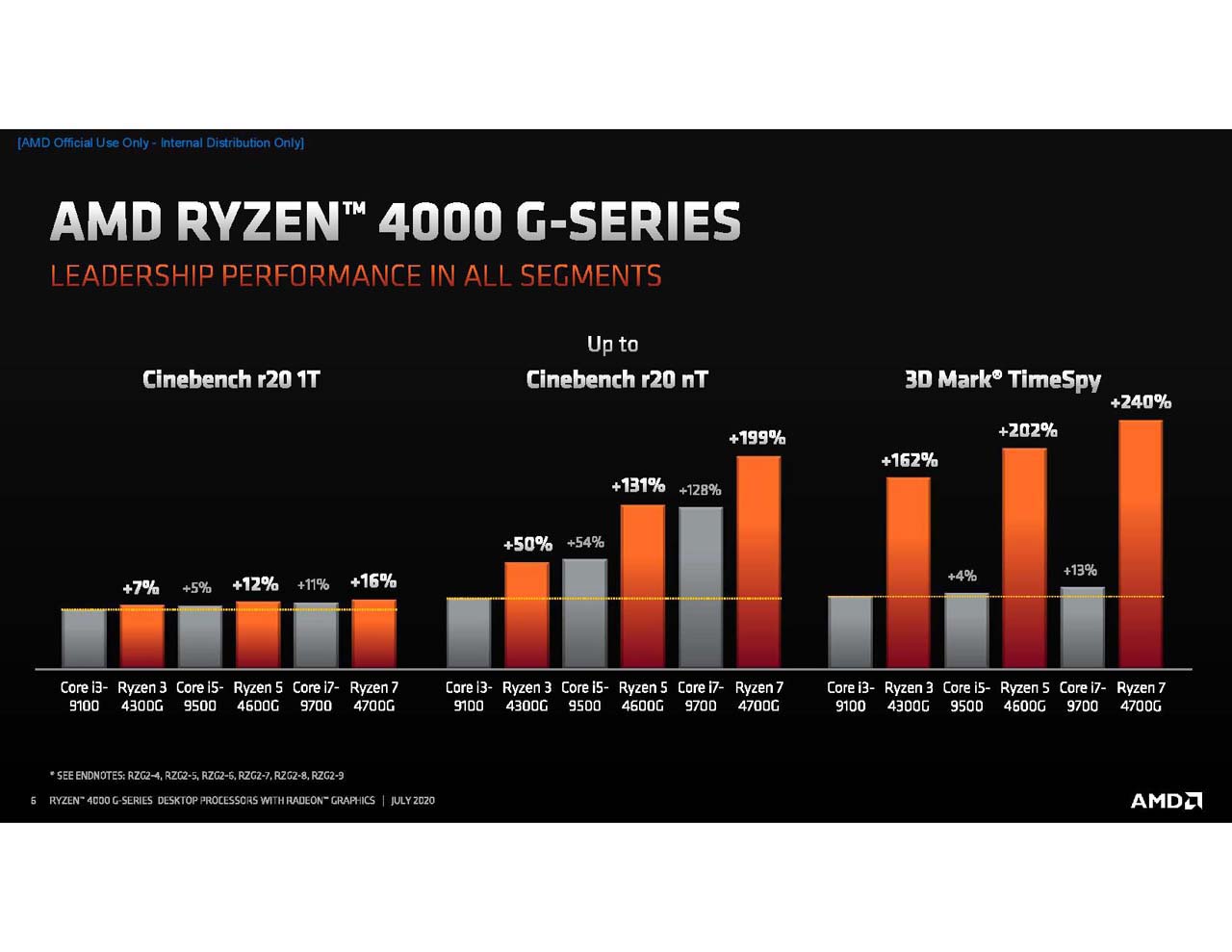

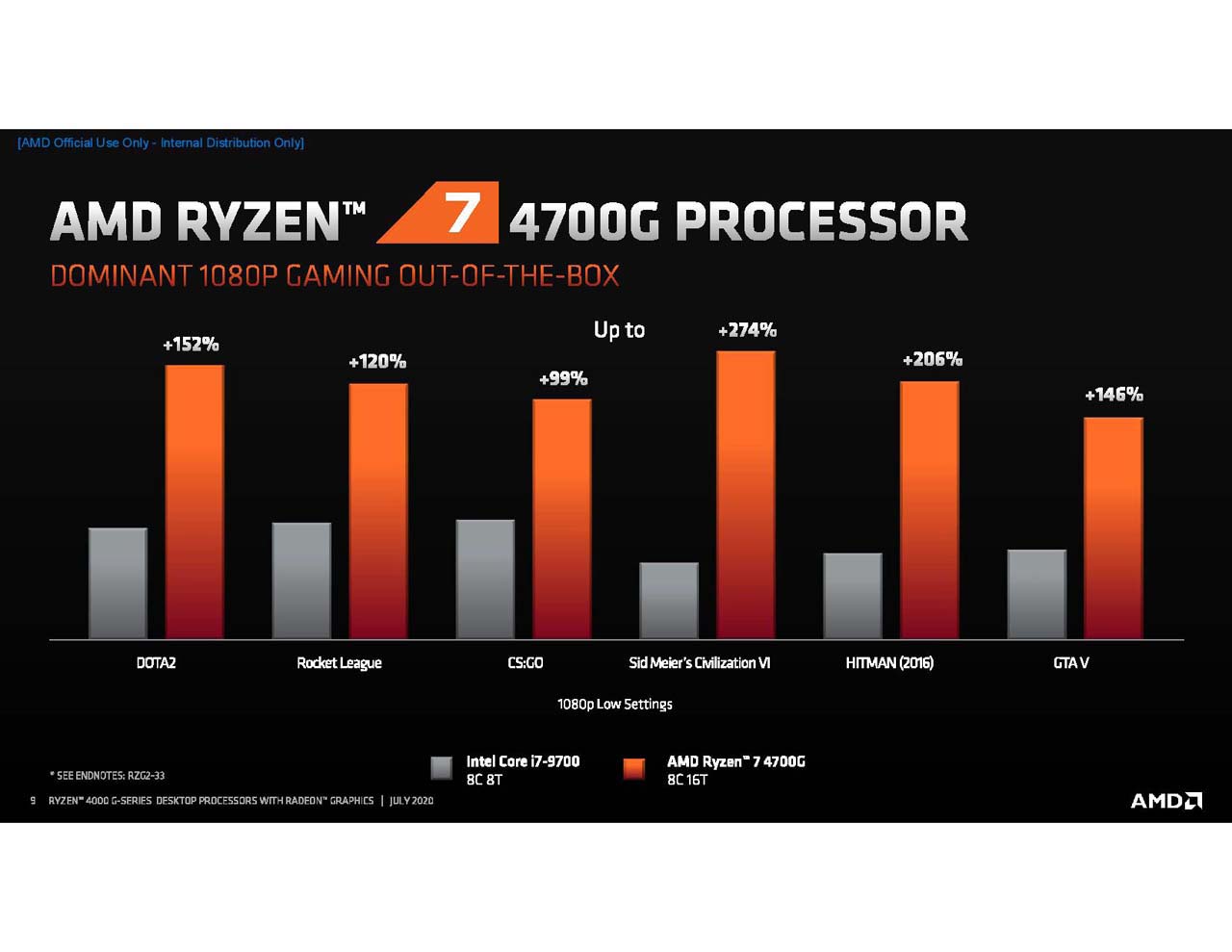



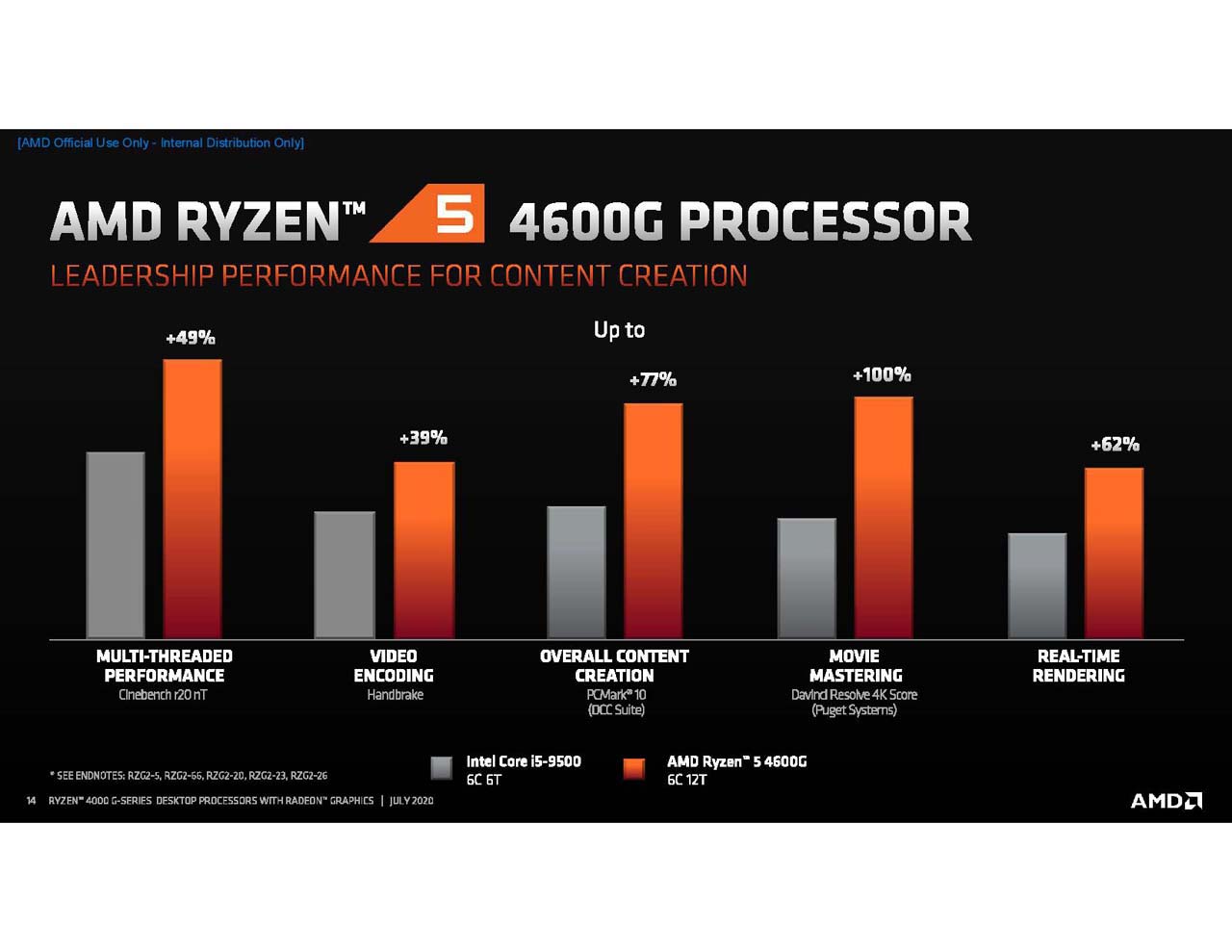
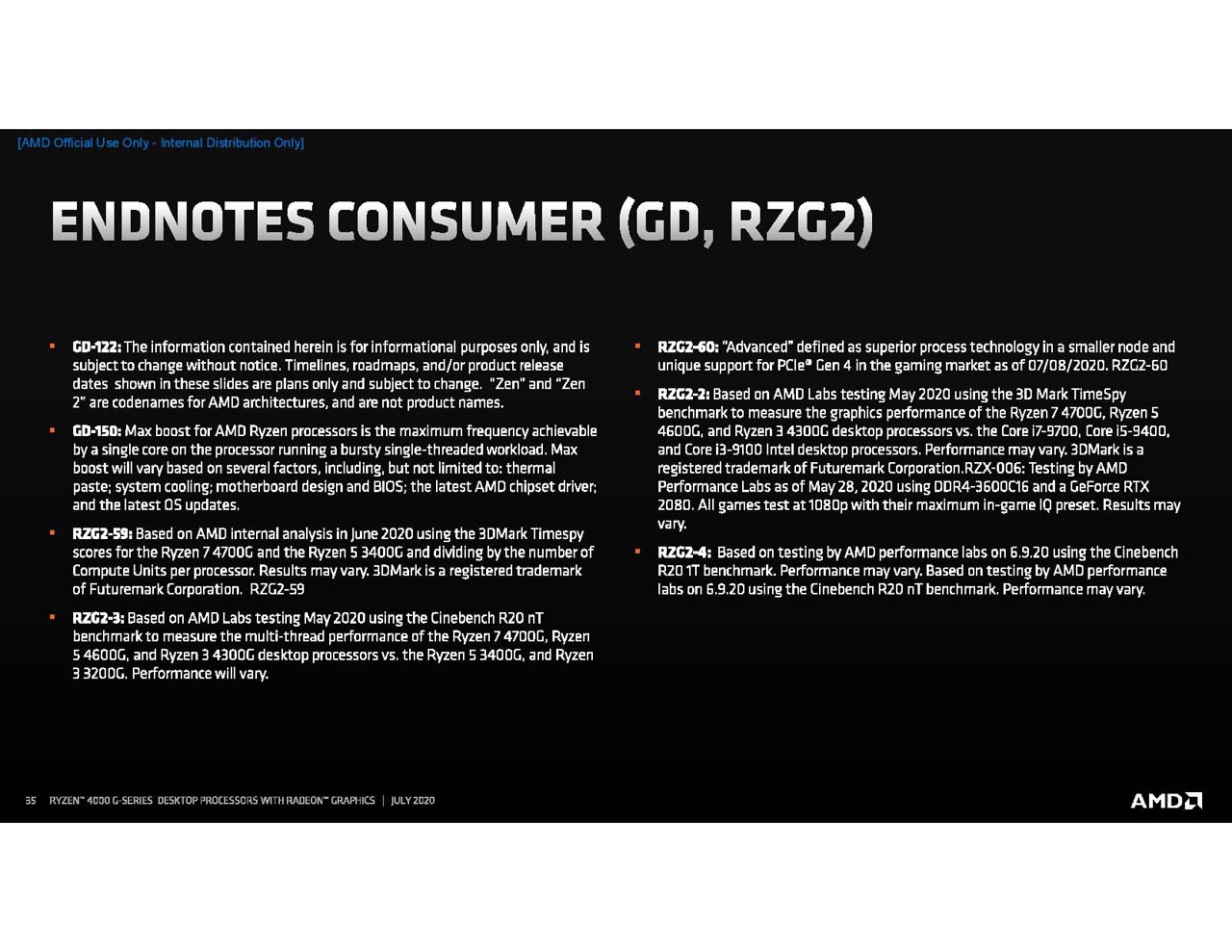
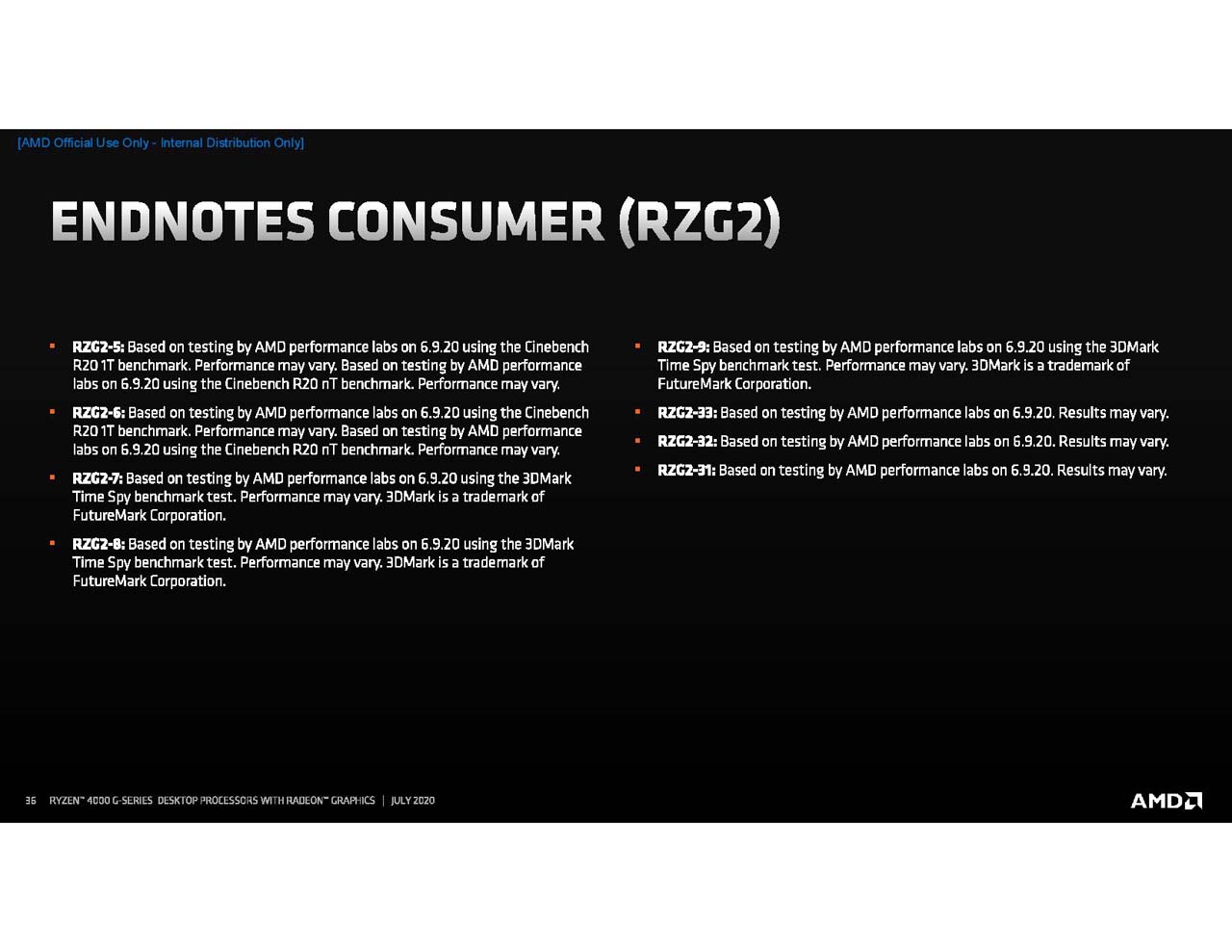


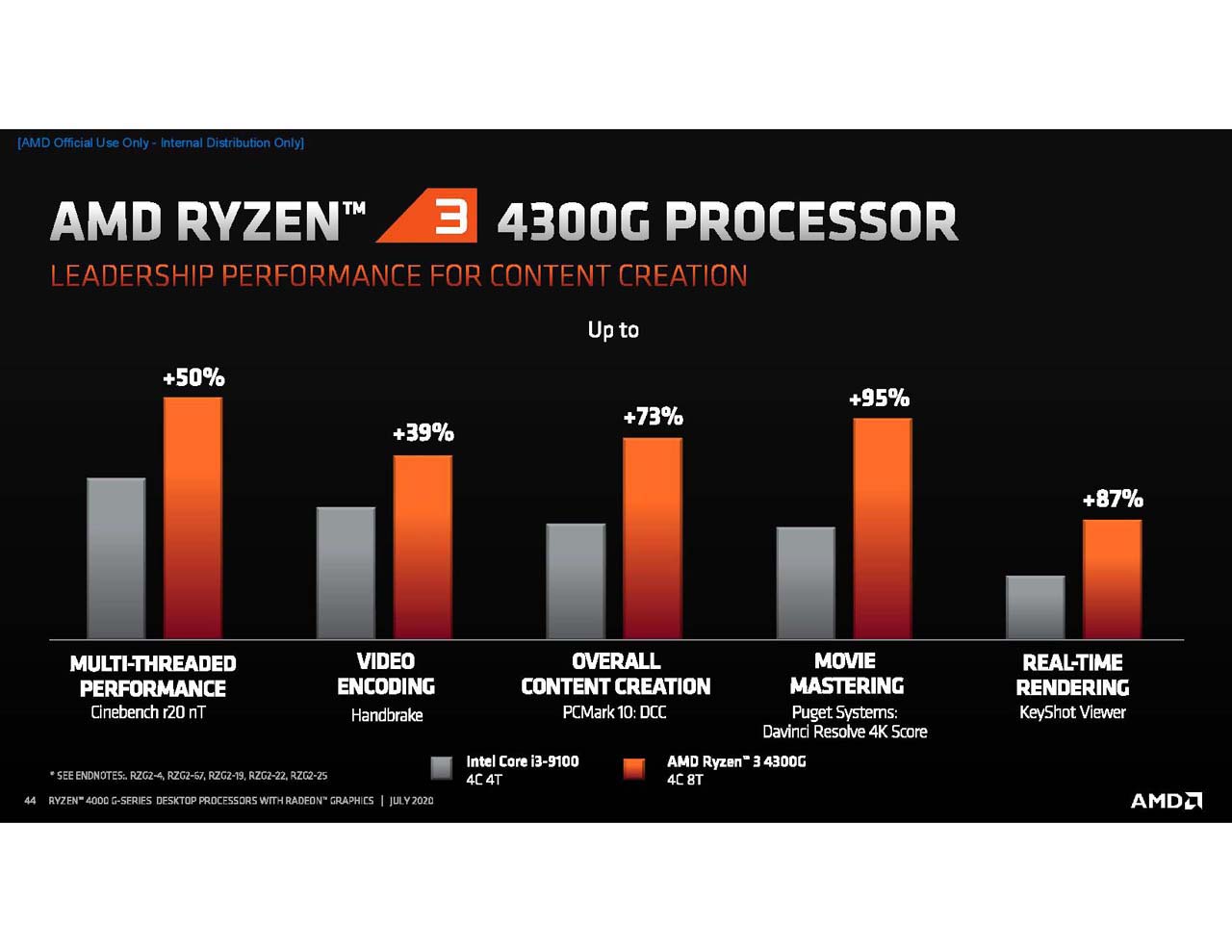
AMD shared some performance data that is included above (endnotes are also in the album). As always, take vendor-provided benchmarks with a grain of salt, but you might take these with a pinch more than usual: The desktop APUs support DDR4-3200, but AMD measured some of its gaming performance metrics with DDR4-3600. [EDIT: AMD reached out to us to clarify that the listing of DDR4-3600 was in error – the company says it conducted the tests at DDR4-3200. In either case, AMD has provided almost no data, aside from the erroneous listing, in regards to its test configurations.]
AMD also provides comparisons to Intel's 9th-gen processors instead of the 10th-gen models, but says it can't source Intel's 10th-gen chips for comparative testing. That's a bit suspect, though it wouldn't help Intel on the Time Spy results as only mobile 10th Gen Ice Lake chips use the newer Gen11 Iris Plus Graphics. We'll have to wait for Tiger Lake and Rocket Lake to see higher performance integrated graphics from Intel desktop processors.
AMD Athlon 3000 G-Series
| Row 0 - Cell 0 | Cores / Threads | Max Clock | Cache | Graphics | TDP |
| Athlon Gold 3150G | 4 / 4 | 3.9 GHz | 6MB | ? | 65W |
| Athlon 3000G | 2 / 4 | 3.5 GHz | 5MB | Vega 3 - 1100 MHz | 35W |
| Athlon Gold 3150GE | 4 / 4 | 3.8 GHz | 6MB | ? | 35W |
| Athlon Silver 3050GE | 2 / 4 | 3.4 GHz | 6MB | ? | 35W |
| Athlon 300GE | 2 / 4 | 3.4 GHz | 5MB | Vega 3 - 1100 MHz | 35W |
AMD also updated its Athlon 3000 G-Series with three new models that come equipped with the 12nm Zen+ architecture and the Vega graphics architecture. AMD didn't share any specifics about the graphics engines, but we'll update as we learn more. As you can see, AMD has adopted Intel's 'Silver' and 'Gold' branding from the Pentium series for these new chips.
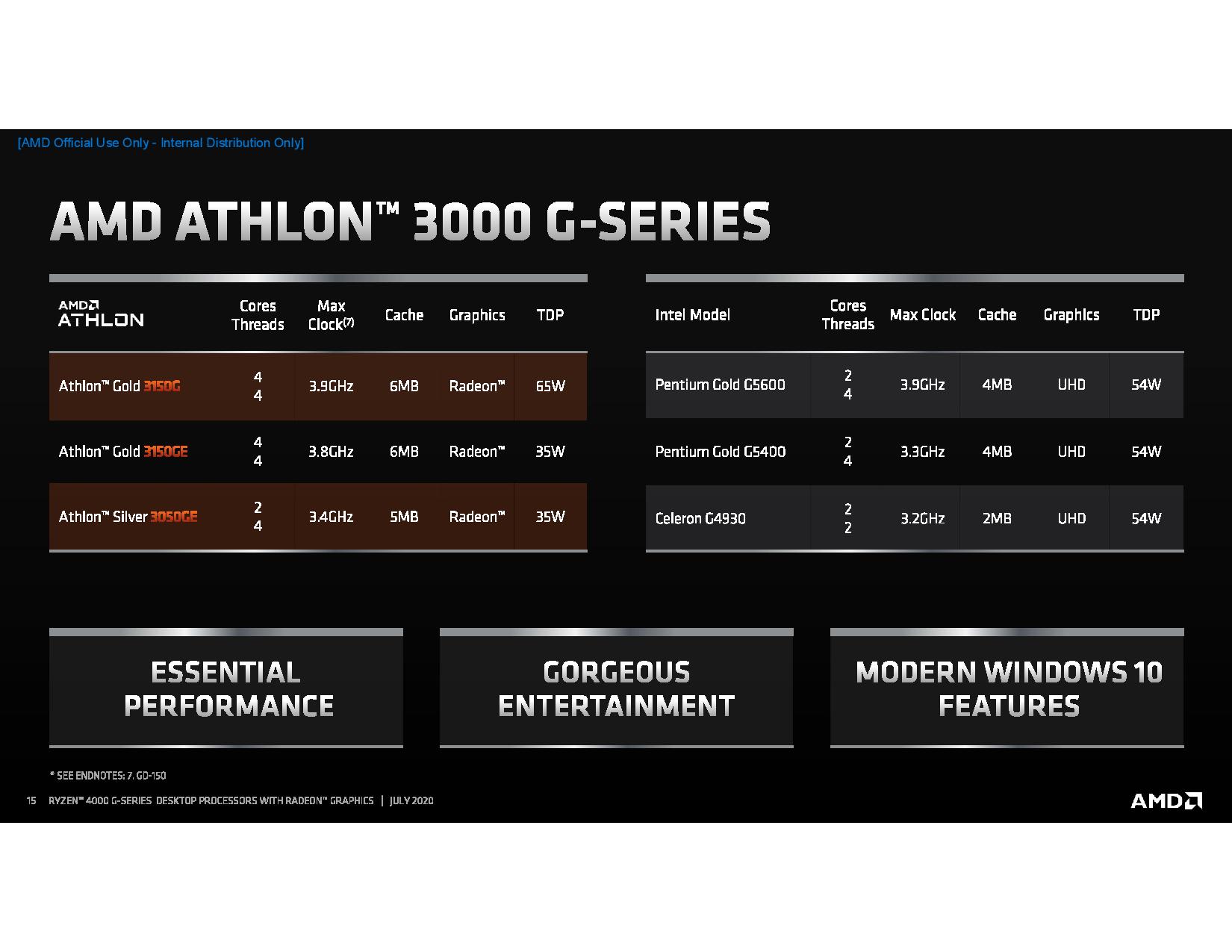
AMD 'Renoir' Ryzen Pro and Athlon Pro 4000 Series
| Row 0 - Cell 0 | Cores/Threads | Frequency | Cache | TDP |
| Ryzen 7 Pro 4750G | 8 / 16 | 3.6 / 4.4 | 12MB | 65W |
| Ryzen 5 Pro 4650G | 6 / 12 | 3.7 / 4.2 | 11MB | 65W |
| Ryzen 3 Pro 4350G | 4 / 8 | 3.8 / 4.0 | 6MB | 65W |


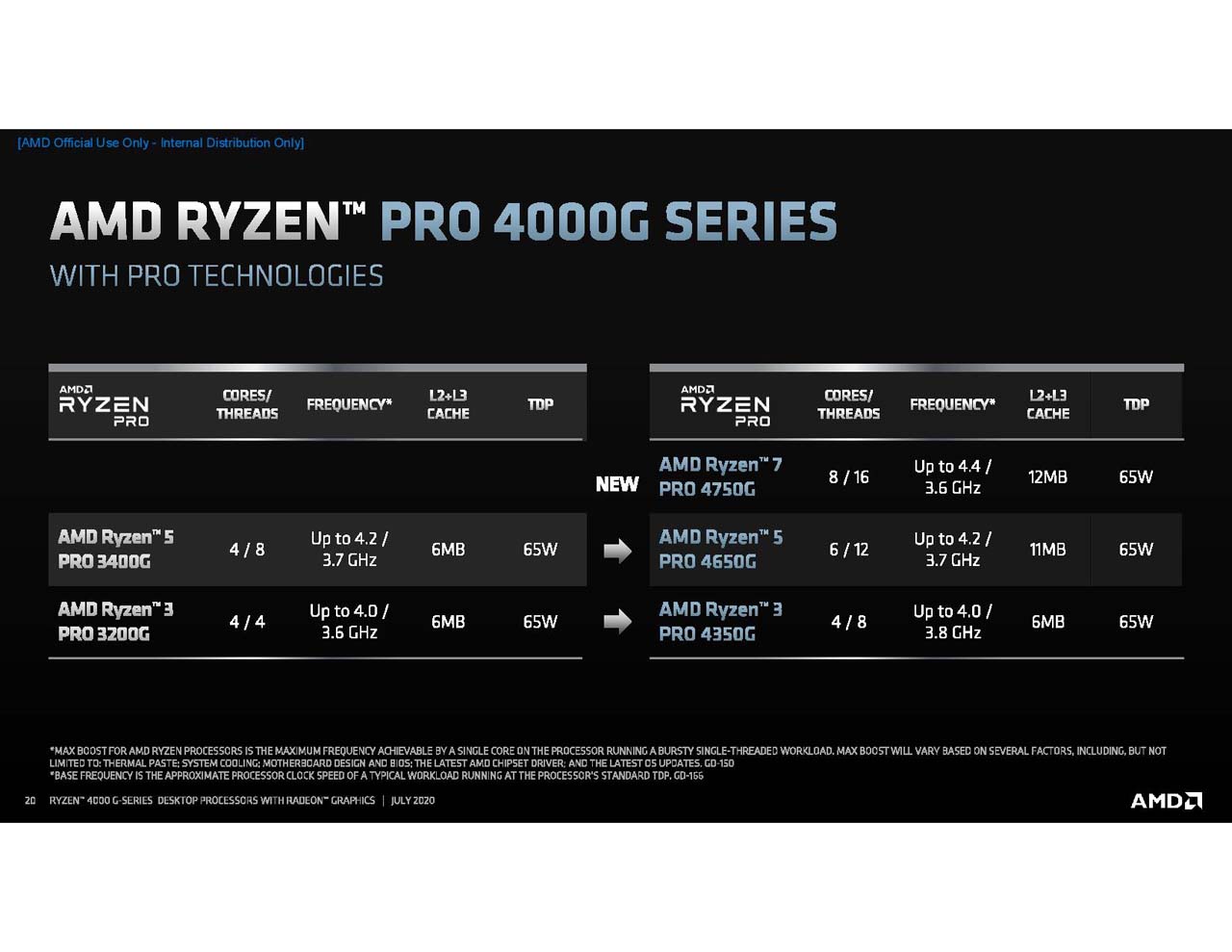
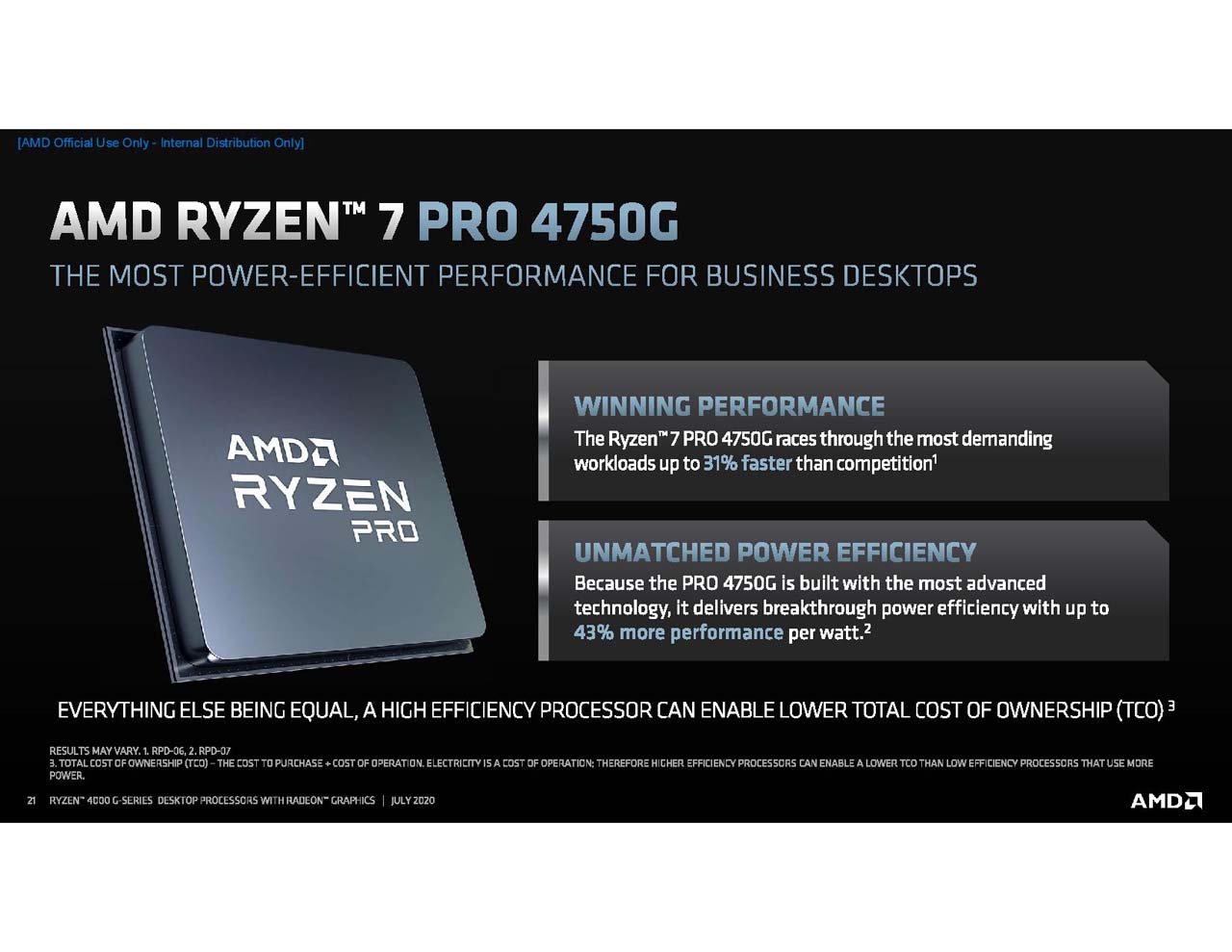
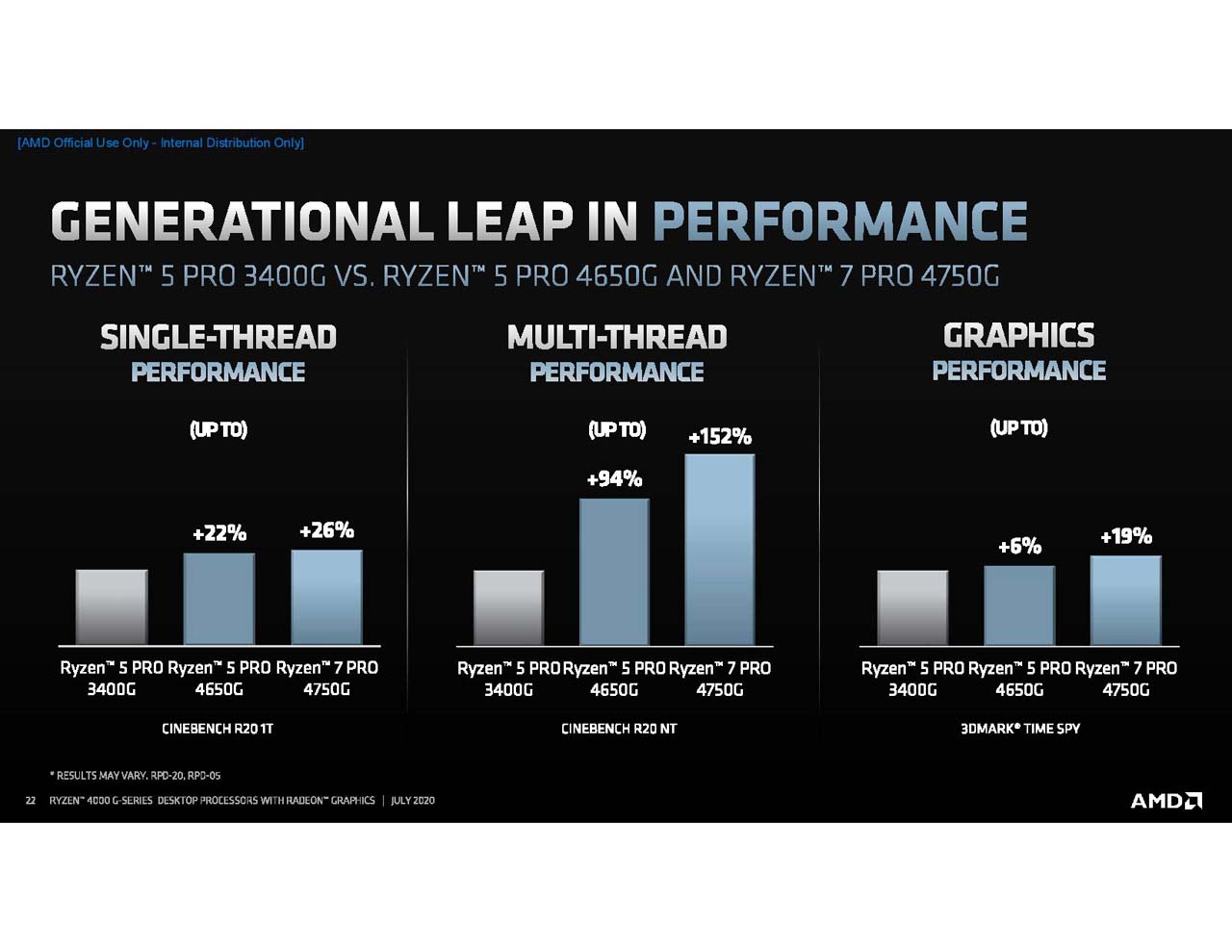
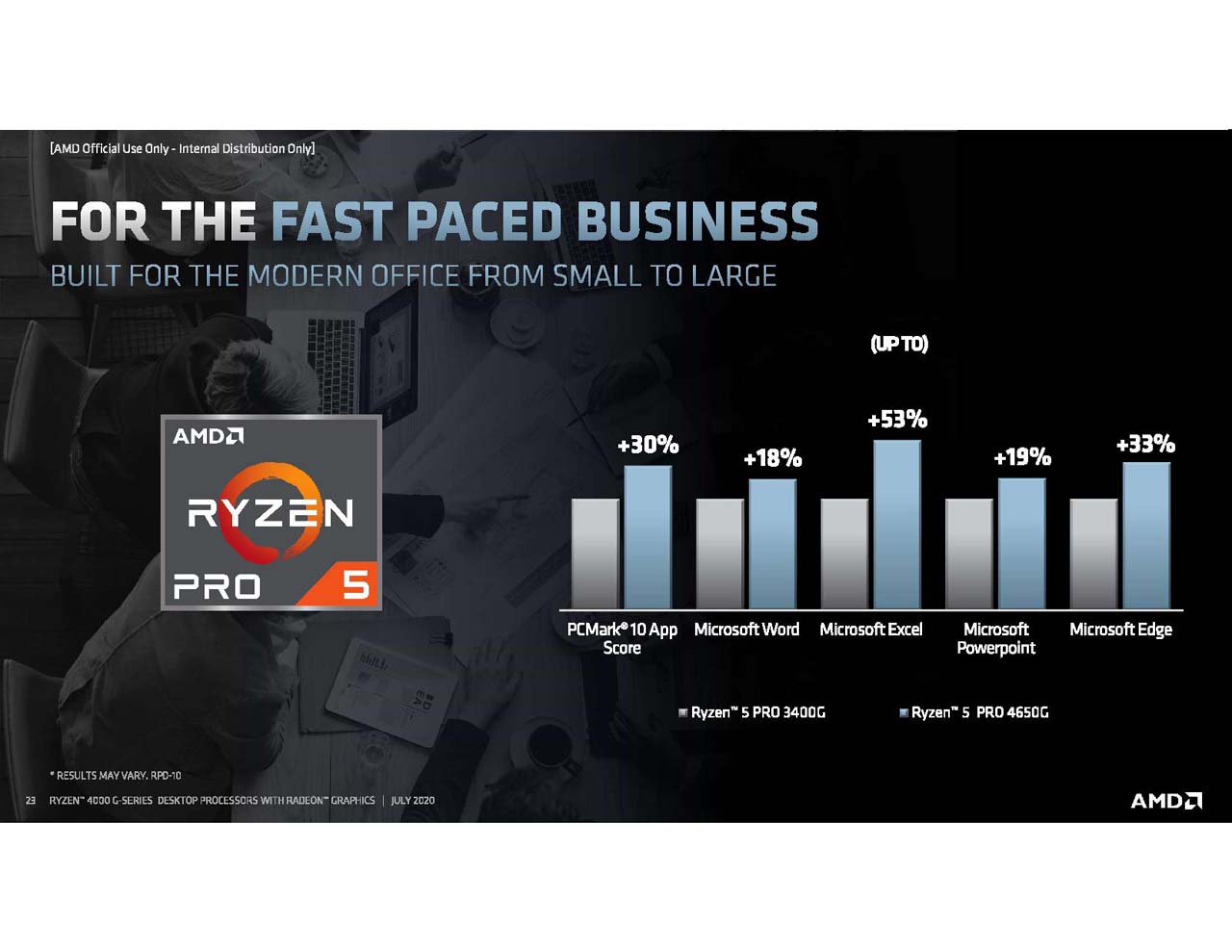

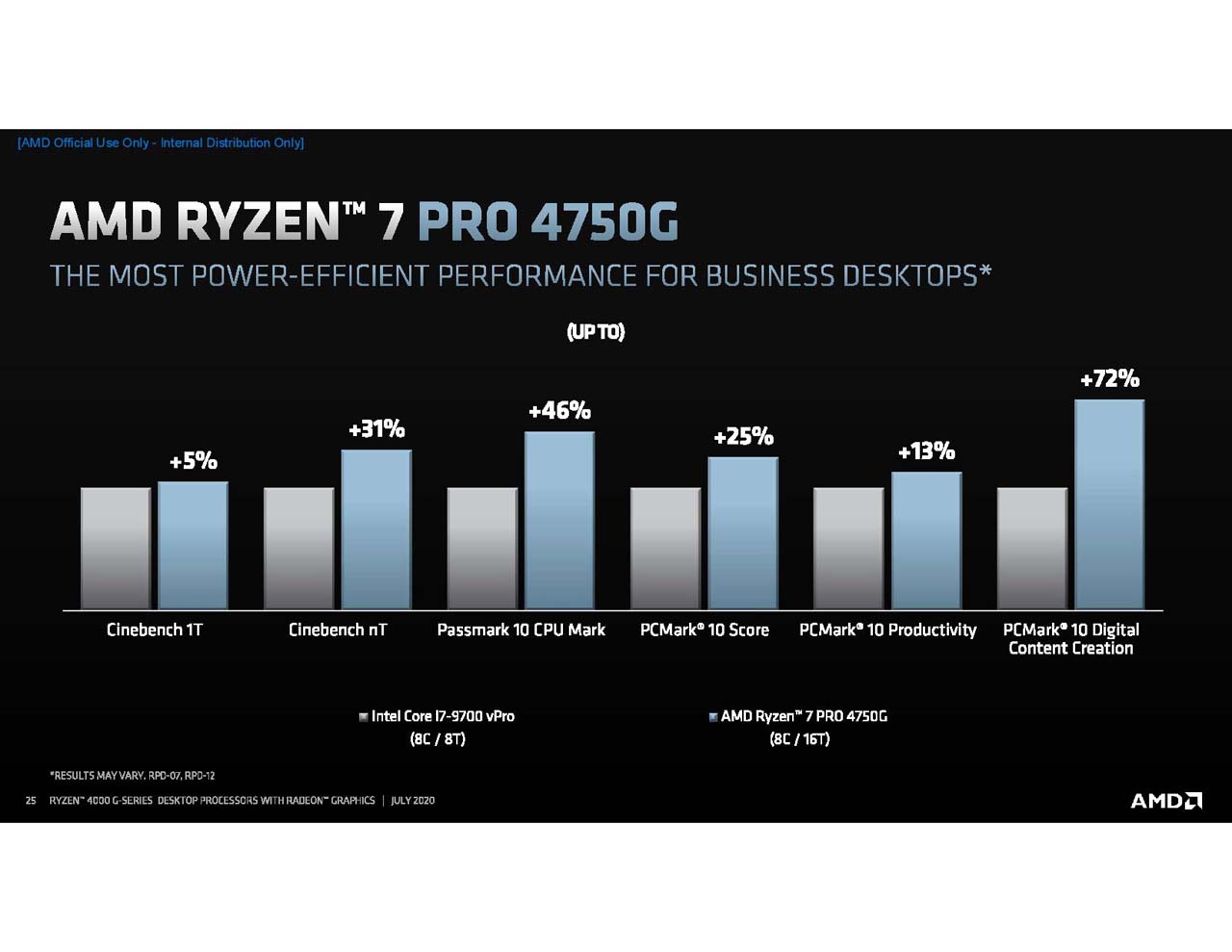
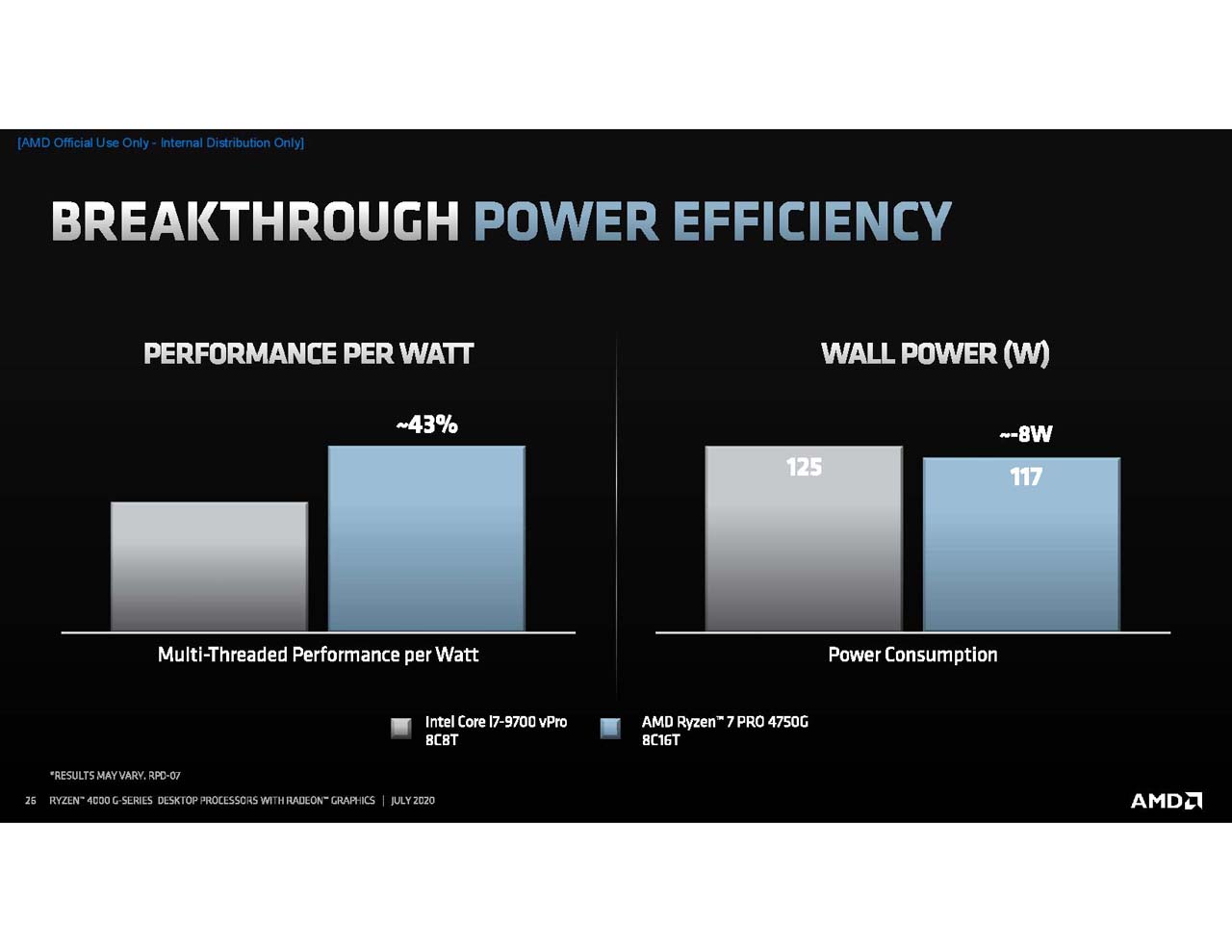
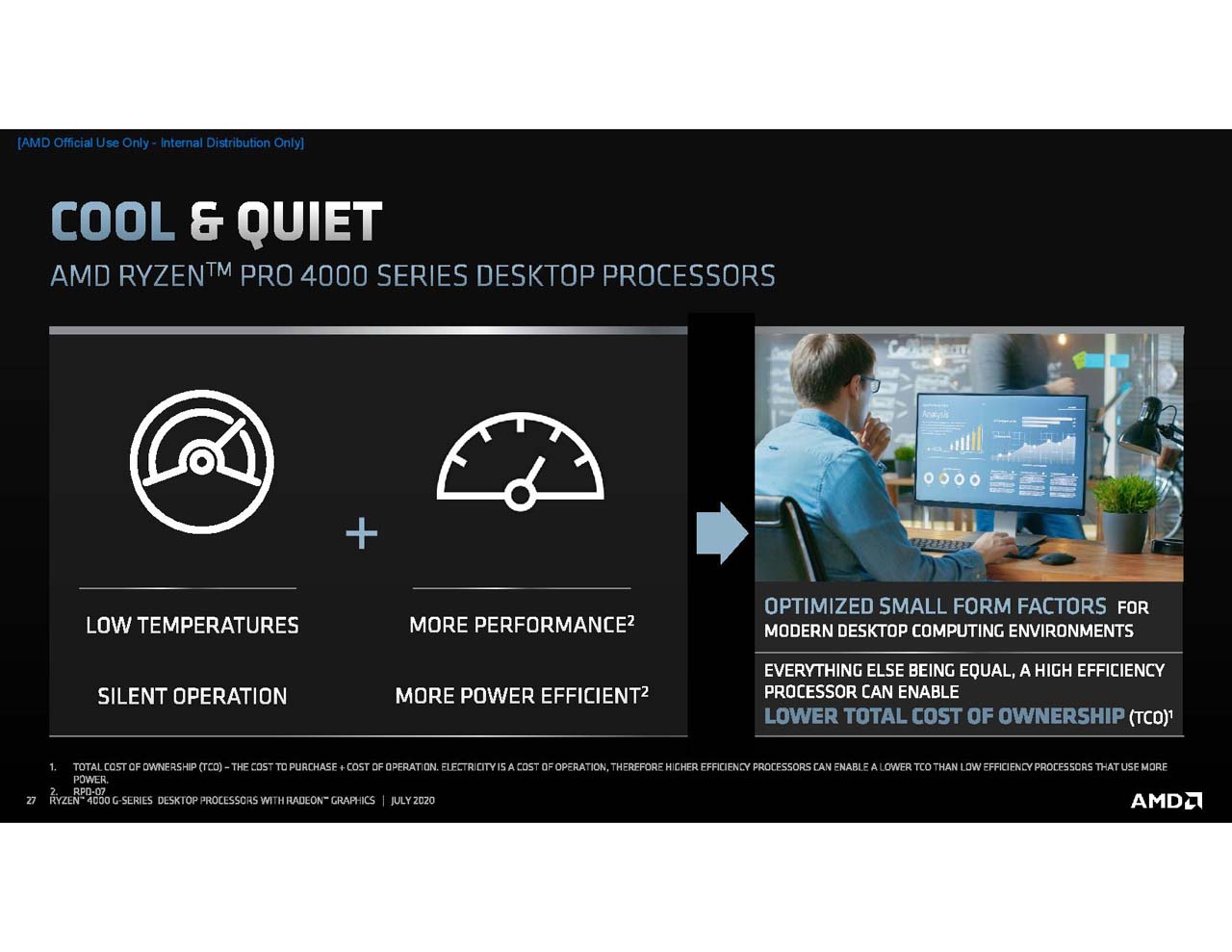
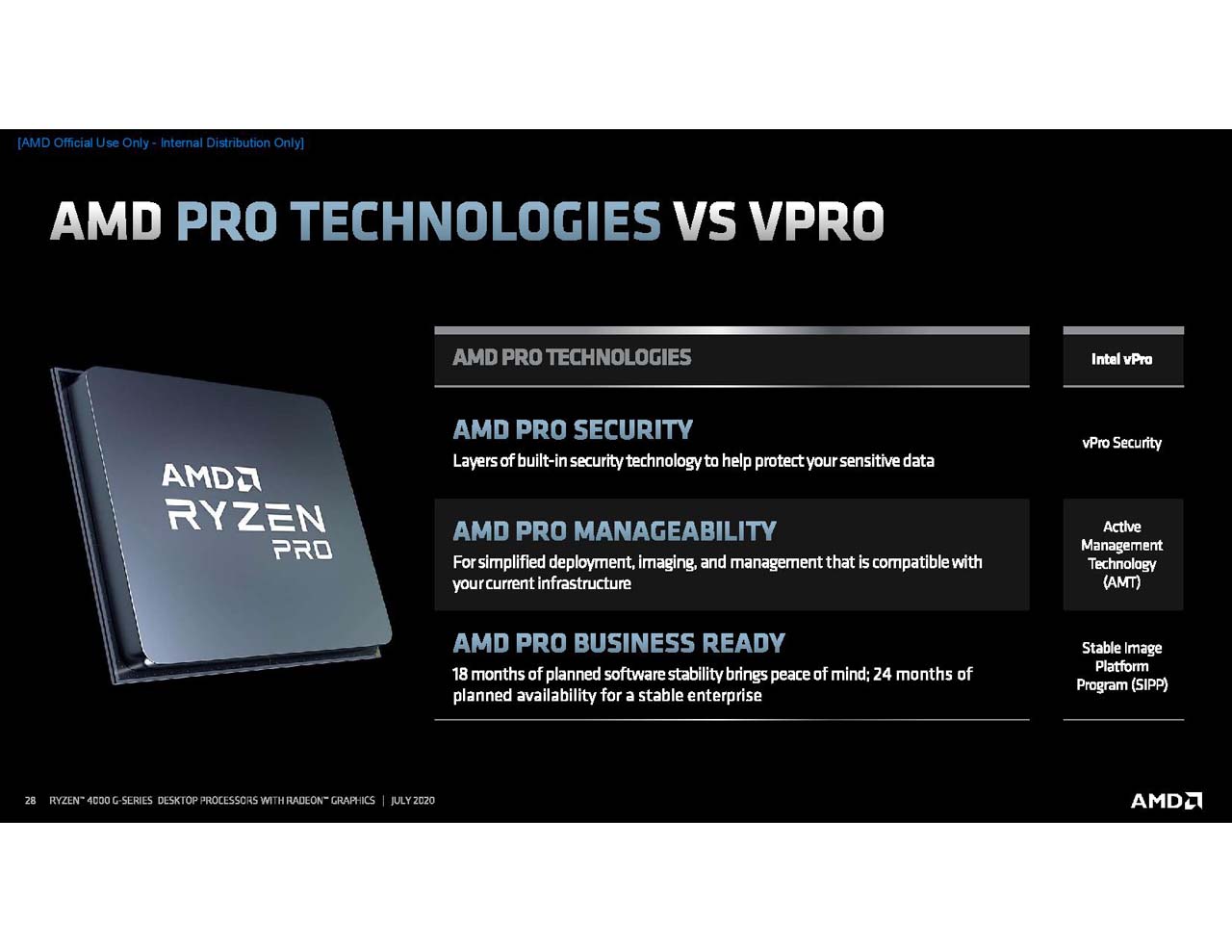

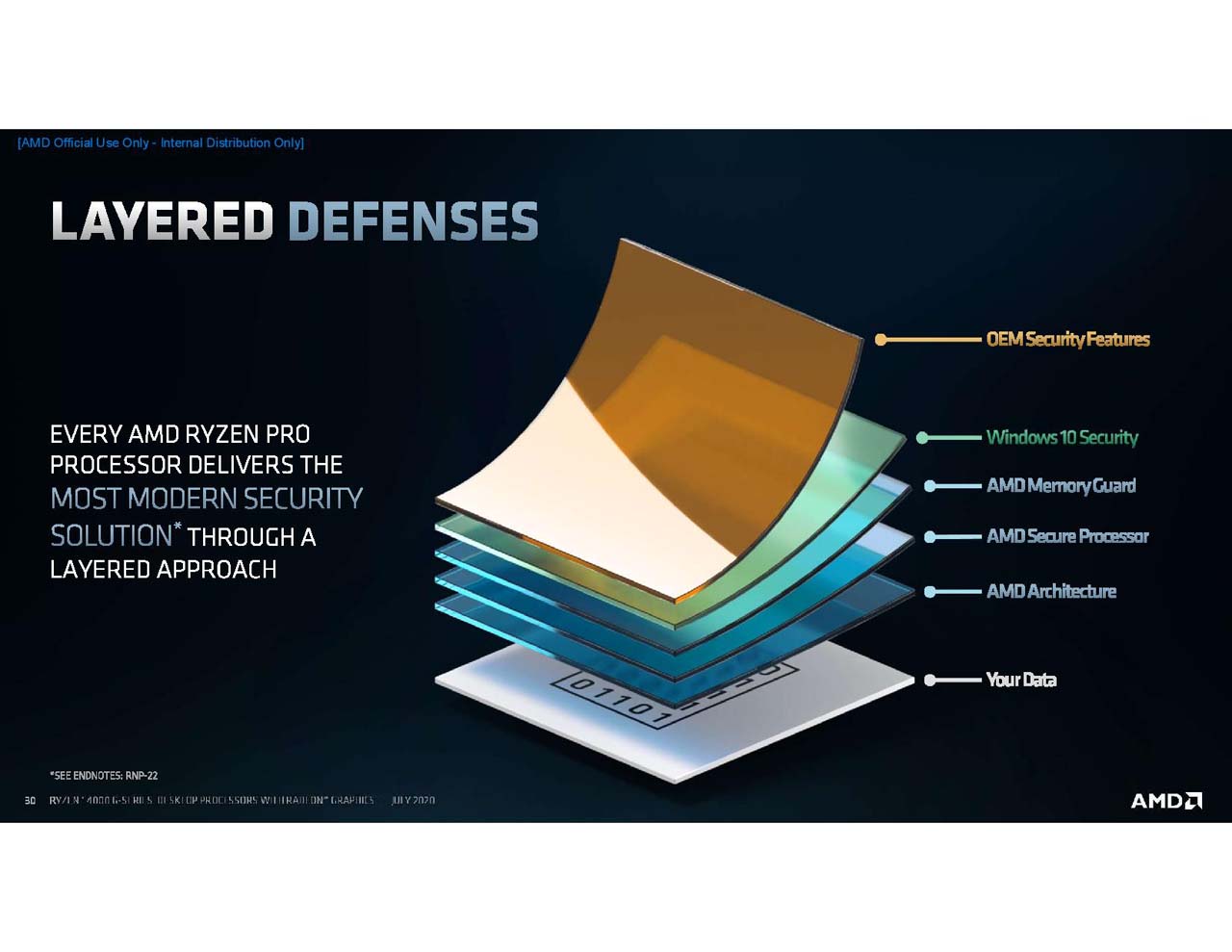


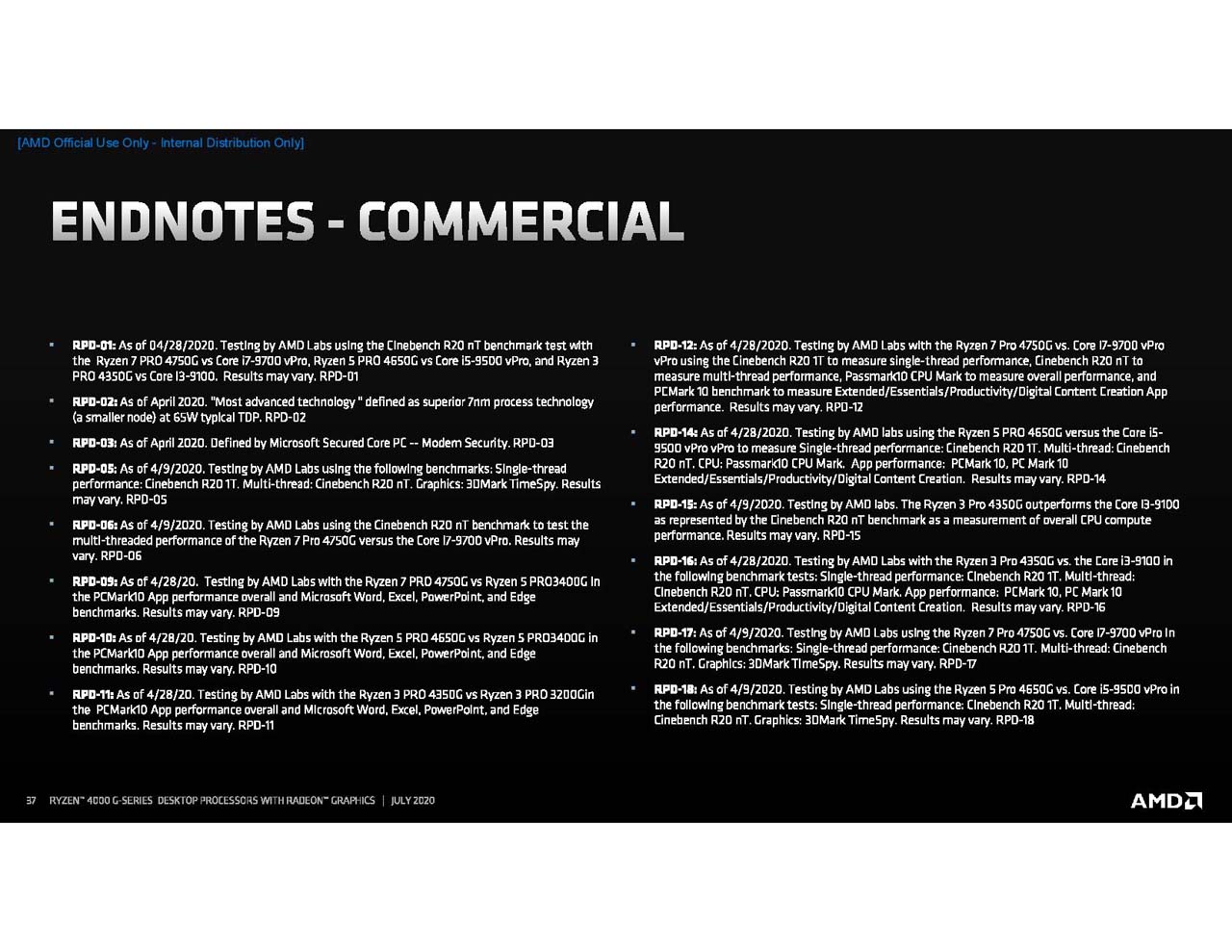
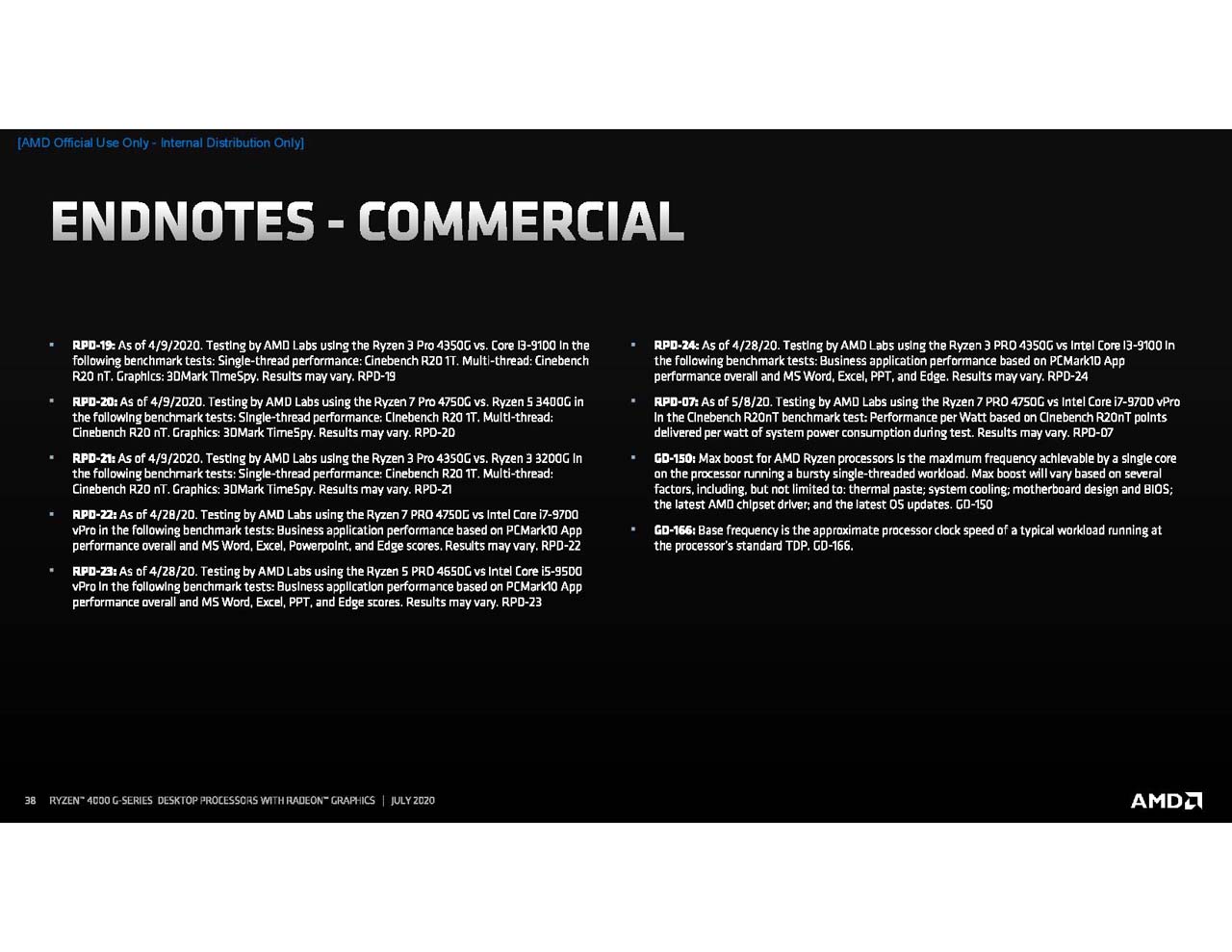
AMD also announced Ryzen Pro 4000 and Athlon G-Series for professional users. These models feature the same specifications as the desktop models but have multiple layers of security, including AMD memory guard that enables fully encrypted memory. The manageability feature includes tools for simplified deployments, long-term imaging (via stable drivers), extended software stability (18 months), and long-term availability of the chips (two years). AMD provided more benchmarks, but again, take vendor-provided performance results with a grain of salt.
Thoughts
AMD's focus on OEM pre-built systems is important for the company as it looks to accelerate its rate of market share gains against Intel. AMD says the pre-built OEM market is roughly four to five times larger than the DIY/enthusiast segment (citing industry analysts), but the company hasn't enjoyed the same amount of success with OEM systems. Much of that disparity lies in the company's previous restriction of only having graphics-enabled chips with a maximum of four execution cores, but the Renoir series changes that paradigm. Renoir expands AMD's maximum core count to eight, allowing AMD to challenge all but Intel's ten-core Core i9-10900/K in pre-built systems that come without a discrete graphics card.
Given the distribution of high-end vs. low-end pre-builts (ten-core pre-builts likely don't comprise a large portion of the sales mix), the Renoir series should be enough to challenge Intel in the vast majority of OEM systems. Given AMD's inherent advantages, like overwhelmingly faster integrated graphics, generally lower price points and much lower power consumption, the Renoir chips could be just the catalyst the company needs to take big strides in the high-volume and lucrative OEM market.
Let's just hope that OEMs pair the chips with capable coolers, motherboards, and dual-channel RAM to get the most out of the architecture. Given what we've seen from Renoir chips in leaked test results, they look exceptionally promising at their higher power rating. Naturally, that will lead to speculation that these chips could disrupt AMD's carefully manicured retail Ryzen 3000 stack, but at a lower price point than the XT- and X-series chips. That means the Renoir chips could be exceptionally potent at gaming with discrete GPUs, thus reducing the need for gamers to purchase more expensive Ryzen 3000 models. We'll see as systems filter out.
AMD says that system integrators (which it defines as builders without a global presence) won't get the Ryzen 4000 G-Series chips for builds. However, leading OEMs like HP and Lenovo are expected to announce systems powered by the new chips soon. Those systems will be available in August 2020.

Paul Alcorn is the Editor-in-Chief for Tom's Hardware US. He also writes news and reviews on CPUs, storage, and enterprise hardware.
-
Pat Flynn Very sad to hear that these won't be available to the builder market at launch. I was very eager to start using these in custom built systems for clients :(Reply -
Flayed This is a shame. Hopefully, Intel will release a really inexpensive display adaptor when they finally enter the discrete graphics market.Reply -
BaRoMeTrIc This is unfortunate, they are seriously missing an opportunity to at least just released 4c, 6c, and 8c retail processors for those looking for high end office, htpc, and sff builds but don't need much more than rx550 performance in the graphics departmentReply -
McGaz Must admit... I think there needs to be a bit of a change with the naming schemes of all these things as it's way too confusing!Reply
We've had the nVidia 2000 series and the 3000 series coming up soon. The Zen 2 with their 3000 series, a refresh of the 3000 series just before the 4000 series comes out, but the 4000 series aren't as good as the 3000 enthusiast CPUs... until the 4000 series comes out.
I have to work out what we're talking about on every new post. I'll bet there's a few ebayers taking full advantage and selling old hardware at new prices! -
msroadkill612 This is rot I suspect: "the chips support a PCIe 3.0 x8 connection to the .... and a x8 connection to the integrated graphics. "Reply
the gpu>cpu link is via Fabric, & afaik, can ~saturate memory bandwidth.
this is hugely significant.
One is an 8GB/s link, the other is ~50GB/s w/ newly ~mainstream 3600 cl16 ram, & 70GB/s+ seems on the cards down the road.
Whenever apuS come up in discussions, the reflexive response of gaming oriented naysayers is "the integrated gpu will always be crap cos it uses slow system memory as gpu cache", yet when ~mainstream system memory shifts from ~30GB/s on raven ridge apu, to ~50GB/s w/ Renoir, it goes unremarked on?
If i am right, then shame on ur misinformationTomsHardware!